Bushcraft & Survival Uses For The Dry Bag.
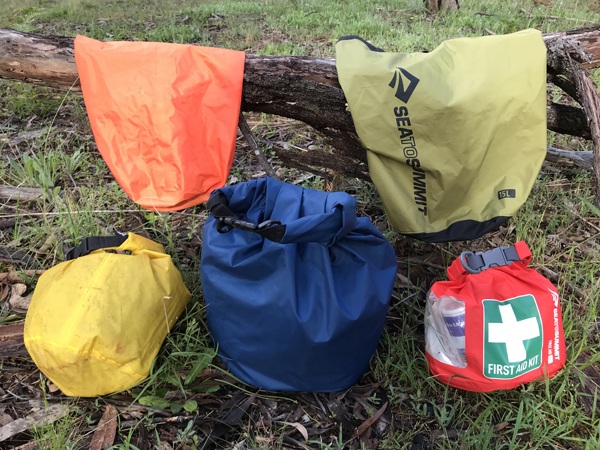
The dry bag is a versatile piece of equipment for bushcraft, survival and outdoors. It has more uses then just keeping clothes dry for kayaking and canoeing.
Here are over 16 uses for the dry bag.
1. Survival kit bag.
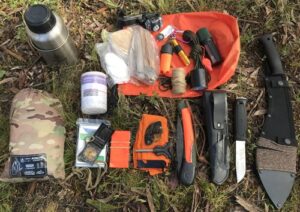
A dry bag can be part of your bushcraft and survival kit. It can help store parts of your 10 Cs of survival kit and layered kit.
The dry bag is ideal for holding smaller items. Or keeping lose items together in your back pack, so you can locate them easier. Like a torch, headlamp, tape, ranger bands, matches or small hanks of cordage.
2. Rain water catchment bag.
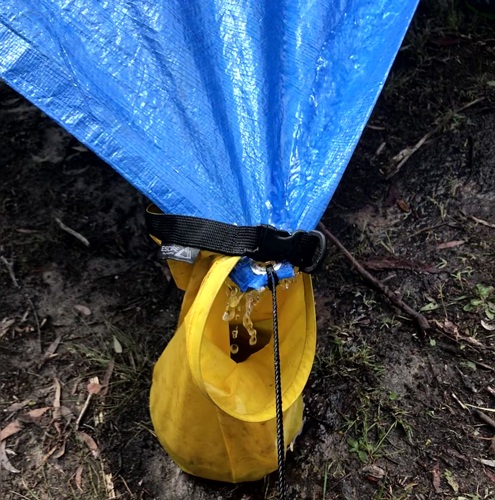
Use a tarp, poncho, large foliage leaves or bark, to funnel rain water at an angle. Place a dry bag underneath to collect the rain water. (Or use a billy tin, for more information visit – Bushcraft And Survival Uses For The Billy Pot.)
3. Bucket.
The dry bag can be used as a bucket to collect water from a lake or stream. (If the water is dirty use a pre- filter like a bandana or hat to filter it. Remember to boil the water before drinking.)
For hotter climates, the dry bag may be handy at base camp for holding extra water, on top of your normal supplies.
4. Stop nasty insects getting inside your boots.
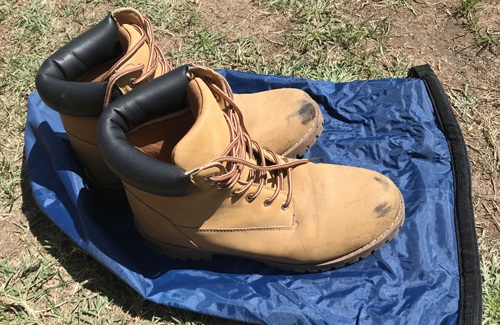
In some places, creepy crawlies can be a concern. To stop spiders and insects, like centipedes and scorpions from making a home in your boots at night time, place the boots in a large dry bag. (Above picture – I think this size dry bag is 15 liters. About 4 gallons.)
The larger dry bag serves three functions for me. I use it to carry my tarp shelter, then at night to store my boots in. I also place my phone, wallet, keys, etc. in the bag overnight. If using a lower profile tarp type set up shelter, I use the dry bag as a mat in the morning. The mat helps me crawl out from the shelter and not get wet knees and hands getting out.
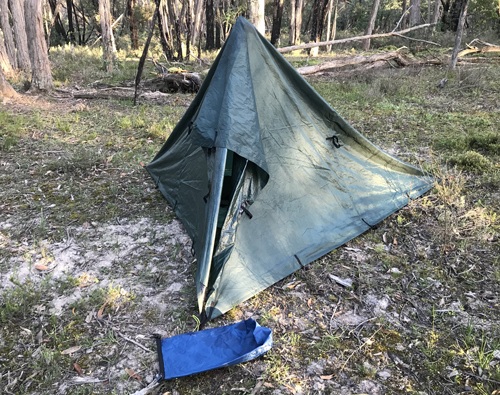
5. Keep fire lighting tools dry.
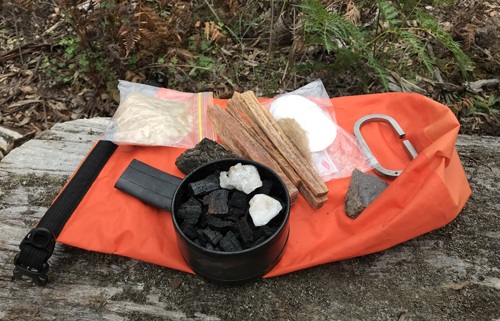
As well as storing general bushcraft and survival kit items, you might use the dry bag to store a dedicated fire kit or tinder and kindling, keeping it bone dry.
Pictured above is a fire lighting kit with flint and steel, char tin, quartz, fatwood sticks, rubber ranger bands, cotton pads with Vaseline, mix of cattail fluff and jute twine in a snap lock bag.
6. Store sleeping system.
A larger dry bag is handy for storing and keeping sleeping bags and bivvy bags dry. If you are using a smaller pack, tying the dry bag externally on top, or underneath the backpack can be an option.
7. Separate wet items in your pack.
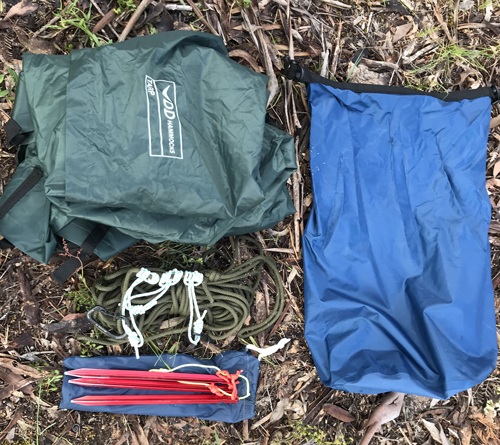
Above picture – DD Hammocks 3 x 3 m tarp with tent stakes and ridgeline.
As well as keeping clothes dry in case the backpack gets soaked through, you can use the dry bag to store wet items.
As an example, if you had to pack up in the morning and your tarp shelter is wet. You may not have time to dry it at that moment, so you place it in the dry bag. This separates the wet tarp from your other dry items in your pack.
Alternative use the dry bag as a dirty laundry bag. Place wet clothes or muddy clothes in the bag.
8. Use the dry bag for a pillow.
The dry bag can be used for a pillow. Put some clothes in the bag or fill it with air. If don’t like the feel of the plastic material, place a jumper over the bag.
You could also stuff natural materials such as leaves, grasses, etc., in the dry bag to pad it out if you have no spare articles of clothing to use.
(A sleeping bag cover or back pack can also be used as a makeshift pillow or case. For more information visit – Improvised Pillows For Camping.)
9. Signaling device.
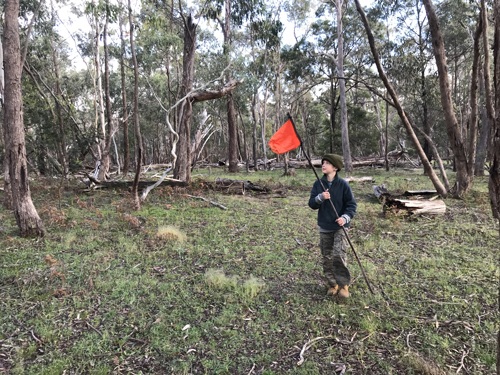
A bright colored dry bag can double as an emergency signaling device, flag, or signal marker panel.
If lost or trying to attract attention, the dry bag can place on a long stick/pole and it can be waived about to attract attention. Just the natural movement of walking will give the flag movement.
When stationary, stand the pole up, ideally more in the open, so the tress or shrubs don’t conceal it. Or tie the bright dry bag high up on a tree branch (Lower, if there is thick leave foliage.)
Fluro orange, yellow and bright blue dry bags might be good colors to use, as these stand out depending on your location. (A brightly colored bandana could also be used for a signaling device.)
10. Clothes washing up tub.
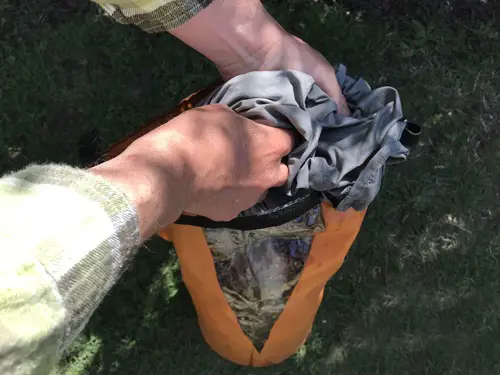
Above picture – Dry bag 15 liters used for washing clothes in.
This tip is not only handy when hiking or camping, but also traveling and jet setting around the globe. A dry bag can be used as a clothes washing tub. Place a drop or two of detergent, or use soap (Some plants can be used as a soap substitute, such as the Yucca root.) with some water in the dry bag. Scrub the cloths in the bag, for your own human powered washing machine.
If you use the dry bag to store water in and are concerned about the detergent / soap in the bag, turn the bag inside out.
When finished washing, don’t throw the water out straight away. Use the dirty water to pour over the fire, to double check the fire is safely out before leaving the camp spot. (Remember to take all rubbish with you.)
11. Fishing buoy or float for a trotline.
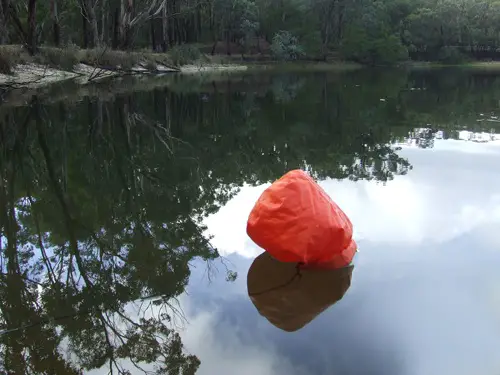
Use the dry bag as a float / buoy to support a survival fishing trotline, gill net or tethered jug line.
Fill the bag up with air and seal it up. Attach it to the trotline to suspend the fishing rig off the bottom snags, or to target fish high up in the water column.
(See the survival fishing trotline, article for many different fishing set ups.)
Depending on size of the fish species, the dry bag can also act as a visual strike indicator when you have a fish on your rig.
If the wind is blowing severely, fill the dry bag with a small amount of water so it weighs more and is lower in the water. Or tether some rocks or waterlogged wood from it.
12. Flotation device.
A quality dry bag can be very buoyant and can have several uses on the water, or in an emergency situation.
The inflated dry bag can be used to assist people in crossing rivers or lakes. Of course it is not a substitute for a properly designed life jacket, PFD, (Personal Flotation Device.) but may help in an emergency crossing for a bit of added buoyancy.
Tie gear to a dry bag to help it float across waterways. (A tarp can be wrapped tightly around a backpack and be used to help swim the backpack across the watercourse as well.)
The dry bag can be attached to the paddle and used as a kayak paddle float to help get back into the kayak.
A larger dry bag with a wider connection strap can be used as stirrup to help get back into kayak, boat or raft.
13. Protect electrical gear.
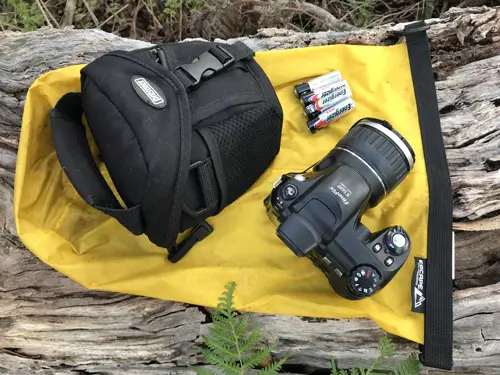
To protect items like phones and cameras from the wet or dust, the dry bag is ideal.
For extra padding for fragile items, wrap a bandanna or Shemagh around it and place in the dry bag to protect it.
14. Use the dry bag as a work mat.
When working on small items, such as removing micro SD cards from a camera, or working with small screws, etc. place the dry bag underneath as a mat.
If you drop the small item, hopefully it will fall on the dry bag and be easy to see. Rather than the item falling onto the forest floor and be impossible to find. (You can use a hat or bandana as well for a work mat.)
15. Foraging pouch.
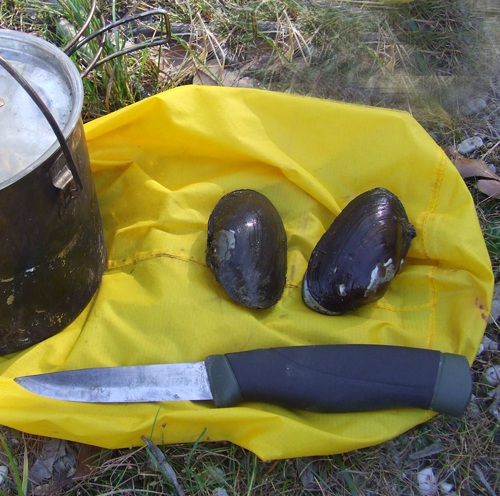
Use the dry bag for a foraging container. The bag can be clipped easily to your belt, to put wild plant edibles in. Grasshoppers, crickets, etc., and other insects can be stored in the bag.
A dry bag is also ideal when collecting shellfish around waterways. The bag could also be used for a live bait container or even a small bait-fish trap.
Be careful though, plants like thistles can puncture the bag. Some grubs like wood grubs can eat through trees, so the plastic dry bag is no match. Also, crawfish (Yabbies’, crayfish.) and spikey creatures, like sea urchins and some sharp shellfish might puncture or tear the bag.
16. First aid kit bag.
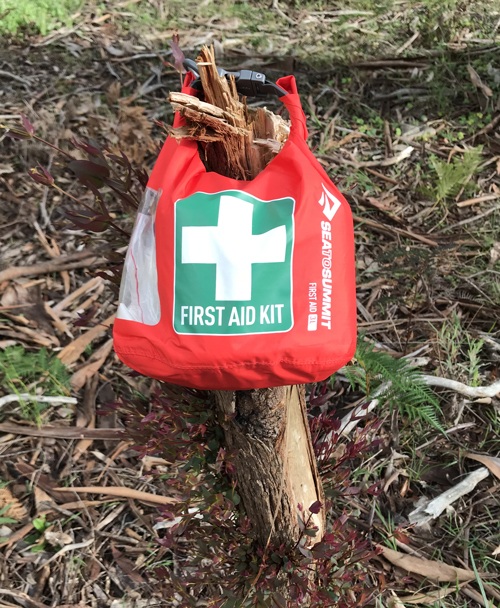
A dedicated dry bag is well suited to store a personal first aid kit. It keeps bandages dry and holds the kit together.
Another advantage is, if you do carry iodine or similar chemicals and the container leaks, it might go through the back pack and on all your gear. A dry bag can keep it from leaking out.
If you haven’t got a dedicated medical bag, like the Sea to Summit first aid bag with the cross / first aid symbol on it, you might use color coded bags. (Tip – Or tape on the first aid cross symbol on it, with some tape.)
As an example you might have a green dry bag for carrying food items, the fire lighting kit in a yellow bag and the first aid kit in an orange bag. This makes it easier to find items quickly in the backpack, especially in an emergency.
Ensure the first aid kit is easily accessible, by being on top, in your pack or in a separate side pouch. I always, (Most times.) tell the children were the kit is stored in the back pack and visually show them, before we venture out in the woods.
Summary – Bushcraft and survival uses for the dry bag.
As it folds up small, weighs very little and has a multitude of uses, the dry bag could be an essential piece of your bushcraft, survival kit or outdoors gear.
